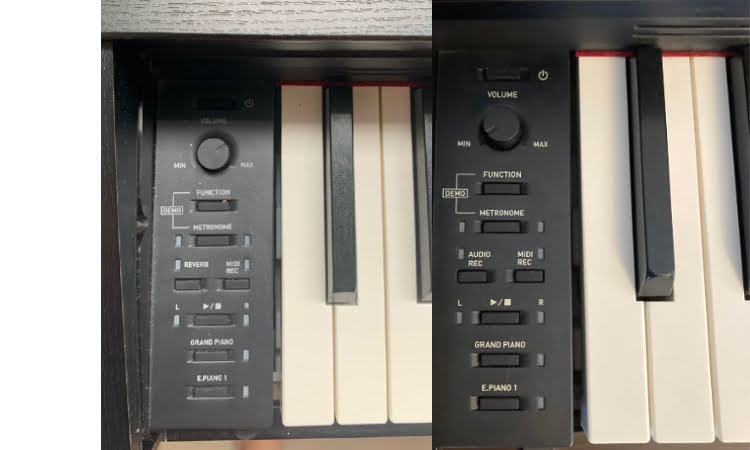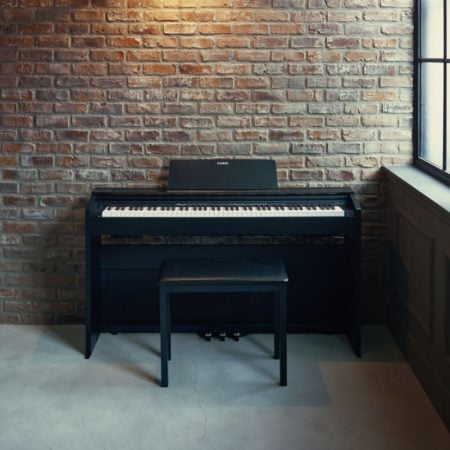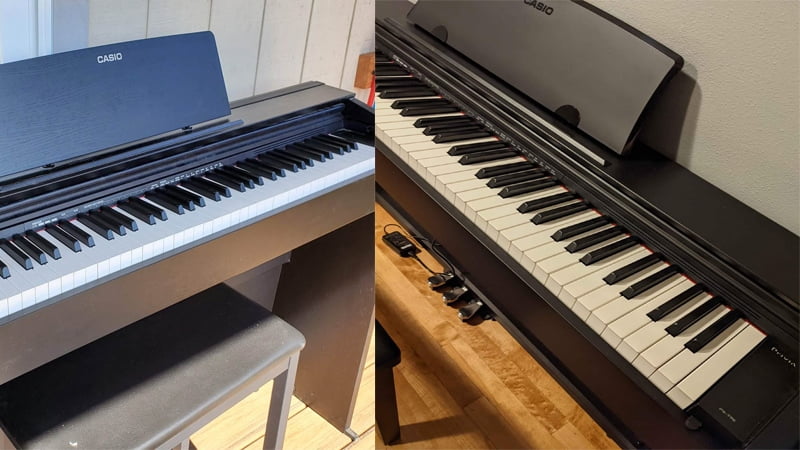Find out if the PX-870 is a worthy upgrade in this Casio PX-770 vs PX-870 comparison!
Since the Casio PX-870 is an upgrade over the Casio PX-770, these two models share a lot of similarities. Since the original PX-770 got so many things right, there weren’t too many things Casio had to change when making the PX-870.
Despite these similarities, there is still a lot to unpack in this Casio PX-770 vs 870 reviews. While I ultimately chose the PX-870 as the winner because of the upgraded tones and sound system, the PX-770 is still a good choice for any pianist out there.
Console digital pianos like these two models usually get a bad reputation because they are tough to transport, bulky, and cost more than your typical portable digital piano.
But as you’ll see in this comparison, there are many reasons you may want to get a console digital piano for your home, especially if someone is learning how to play the instrument.
Casio PX-770 vs 870: Comparison Chart




Last update on 2025-07-08 / Affiliate links / Images from Amazon Product Advertising API
Casio PX-770 vs 870: The Features
While these two pianos have a lot of similarities, their features had slight differences in the details that are worth talking about. And when comparing the two models, the Casio PX-870 won out with a score of 3-2.
As the score suggests, it was a very close battle, and if it weren’t for the upgraded sound system on the 870, these two models would have easily been tied.
Tone
The winner: Tie
Just because these two were tied in terms of tone, doesn’t mean they have the exact same sound. The Casio PX-770 and the 870 both use the same tone engine and have the same sound library.
However, it is worth noting that the voices on the PX-870 are a bit better than the PX-770, since the tone engine received some small upgrades.
+Tone Generation
Both pianos use the Casio AiR or Acoustic Intelligent Response tone engine. While it may sound complicated, both pianos basically use samples to generate their tone.
With that said, the AiR system is known for much better and more realistic sounds than other pianos in the same price range. And for the PX-770 and the PX-870, this rings true. Both pianos will produce very realistic tones, which is about what is expected from a console digital piano.
However, the PX-870’s tone engine has slightly better samples than the PX-770, which is one of the reasons it has a higher price tag. And while the samples are better on the PX-870, I don’t think that it’s that much better to justify the higher price tag.
So, at the end of it all, these two pianos were tied when it came down to the tone.
+Sound Library
Granted, most digital pianos on the market today only have 10-12 different tones, so both pianos still offer more variety than a lot of other options.
With the PX-870 and the PX-770, you get a variety of acoustic and electric piano, strings, synth, bass, and even organ voices.
If you’re a beginner, these are more than enough to cover your journey into music. In fact, most piano teachers recommend getting options with lesser voices when starting out, so you don’t end up getting distracted by all the different voices loaded into your piano.
Another major reason I found that these two pianos were tied in the tone category is because of the sound library. I expected the PX-870 to come with more voices since it’s the more expensive option. However, I was kind of let down since both the PX-870 and the PX-770 come with 19 different voices.

Feel
The winner: Tie
As console digital pianos, you can expect both options to have a very realistic feel. And when testing out both of these options, I could barely tell them apart. Both used the same hammer action system and sported a coating on the keys, which made for a feel very similar to an acoustic piano.
+Hammer Action
To start, let’s talk about hammer action. Both pianos have a version of scaled or progressive hammer action on the keys. This means that the keys on the left side of the piano are slightly heavier than the ones on the right side of the piano.
This is exactly how an acoustic piano is weighted, which is a major reason many people enjoy the feel of either the PX-870 or the PX-770. With that said, since the PX-770 is the cheaper option, it’s actually a slight surprise that it comes with the same hammer action system as the PX-870.
When playing either of these pianos, the action was consistent with how an acoustic piano feels. Now, for beginners, this could make it harder to play the instrument, but it’s all worth it since you’re developing your finger muscles to easily press down on weighted keys.
That way, switching from either the PX-870 or PX-770 to an acoustic piano will be a breeze.
+Key Texture
One of the common complaints I have with most entry-level digital pianos is the glossy and plastic key texture. Luckily, Casio did something about this for both the PX-870 and PX-770.
While the pianos still utilize plastic keys, they do have a coating that is designed to mimic the texture of ebony and ivory keys. It would have been nice if the pianos used wooden keys, but that would have jacked up the price significantly, making both options less affordable for beginners.
The coating on the keys does a fair job at replicating the texture of wooden keys. However, when testing it out myself, I still noticed a slight difference, though it admittedly wasn’t as glaring as the texture difference when playing with uncoated plastic keys.
Sound System
The winner: Casio PX-870
Now it’s time to get down to the main reason the Casio PX-870 is a worthwhile upgrade over the PX-770: the sound system. When practicing, performing, or jamming with other musicians, it’s important to have good speakers.
After all, what good are all the premium voices on your digital piano if they are coming out of bad speakers?
The Casio PX-770 comes with fairly decent speakers. Basically, the PX-770 has two speakers with one tweeter and one woofer each. So, you get balanced bass and treble tones with a fair amount of mids when playing around with the PX-770.
With that said, the PX-870 does a much better job. This piano comes with a four way speaker system not only designed to deliver high-quality audio, but to deliver it in the same way as an acoustic piano.
That way, the sound from the PX-870 hits the audience and musician the same as an acoustic piano. Granted, this is a very fine detail that most beginners won’t notice, but since these pianos are so close together, the fine details are what set them apart.
And after rigorous testing, I figured that the difference in the sound systems was large enough to definitively declare the PX-870 the winner, though by very slim margins.

Casio PX-770 vs 870: The Similarities
These two pianos are from the same company and same product line. In fact, the PX-870 is the model right after the PX-770, so you can expect them to share a fair amount of similarities.
For starters, let’s talk about the tone. We already discussed that the voices on these pianos are very good, with the PX-870 holding a slight edge. But despite the small differences, both pianos use the exact same AiR tone engine. On top of that, they even have the same sound library, so you get the same tonal variety with both options.
Additionally, these pianos are equipped with the same hammer action system and coating on the keys. So, when testing them out, I noticed that the feel was exactly the same, and if it weren’t for the sound differences, I probably wouldn’t be able to tell them apart.
Another similarity that we didn’t mention earlier are the effects on both pianos. For a console digital piano, both models offer a fair amount of versatility. With built-in reverb, modulation, and brilliance effects, you can take full control over your tone and make all the necessary tweaks until the sound matches your tastes down to the final details.
With these effects, you can give your piano a “wobbly” effect for more modern styles of music. And if you’re playing classical piano and just want more body in your tone, you can simply use the reverb effect and add a whole new dimension to your piano’s sound.
Lastly, both of these pianos offer lesson mode for when you’re at your piano lessons. This makes it easier for the teacher to demonstrate certain techniques, and can also make for a smoother overall learning process.
So, if you’re looking for a versatile console digital piano with great tones, realistic feel, and a fairly wide sound library, both the Casio PX-770 and the PX-870 will serve you well.
Quick Rundown of the Casio PX-770
- IMMERSIVE GRAND PIANO SOUND – Award-winning AiR Sound Source with stereo grand piano, damper resonance, and 19 tones for rich, expressive performances.
- REALISTIC TOUCH & FEEL – 88-key Tri-Sensor II Hammer Action with ebony/ivory-feel keys, adjustable touch sensitivity, and hammer response.
- CLEAR, POWERFUL AUDIO – Built-in stereo speaker system delivers detailed, balanced sound across the full range.
- BUILT FOR LEARNING – Duet Mode, dual headphone jacks, 60 built-in songs, MIDI recorder, and Concert Play orchestral backing tracks.
- SLIM, STYLISH DESIGN – Elegant cabinet with sliding key cover fits any décor. USB-MIDI port connects easily to Mac, PC, iOS, or Android—no drivers needed.
Last update on 2025-07-08 / Affiliate links / Images from Amazon Product Advertising API
Quick Rundown of the Casio PX-870
- TRUE PIANO FEEL & EXPRESSION – 88-key Tri-Sensor II Scaled Hammer Action delivers authentic touch with simulated ebony and ivory textures, offering remarkable feel and superior dynamic control.
- IMMERSIVE GRAND PIANO SOUND – The AiR Sound Source delivers rich detail with advanced damper and string resonance, key-off simulation, and mechanical sounds—recreating the full depth of a concert grand.
- POWERFUL 40W SOUND SYSTEM – 4-speaker Sound Projection system fills your space with rich, immersive sound, plus Headphone Mode for quiet practice.
- The Tri-Sensor Scaled Hammer Action II keyboard has an incredible feel and captures the dynamics of a performance with unparalleled speed and accuracy
- BUILT FOR LEARNING – Duet Mode, dual headphone jacks, 60 built-in songs, 2-track MIDI recorder, and Concert Play with orchestral backing tracks.
Last update on 2025-07-08 / Affiliate links / Images from Amazon Product Advertising API
Product Videos
Related Articles to Casio Px 770
- Casio PX-770 vs Korg B2SP: A Battle of Budget Console Digital Pianos?
- Casio PX-770 vs Kawai KDP-110: The Best Console Digital Pianos on a Budget?
- Casio PX-770 vs Kawai ES-110: Should You Get A Portable or Console Digital Piano?
- Casio PX-770 vs PX-160: Should You Get A Portable or Console Digital Piano?
- Casio PX-770 vs S1000: Should You Get A Portable or Console Digital Piano?
- Casio PX-770 vs 750: Finding the Best Budget Digital Piano
- Casio PX-770 vs PX-860: Should You Get A Portable or Console Digital Piano?
- Casio PX-770 Vs AP-270: Which Casio Model Wins Out?
- Casio PX-770 Vs 760: Which Is The Better Casio Privia Model?
- Casio PX-770 Vs Yamaha DGX-660: Should You Get A Portable Or Console Digital Piano?
- Casio PX-770 Vs Yamaha YDP-143: Which Is The Better Piano For The Money?
- Casio PX-770 Vs Roland FP-30: Should You Get A Portable or Console Digital Piano?
- Casio PX-770 vs Yamaha YDP-144: Which Is The Better Digital Piano?
- Casio PX-770 Vs 780: What’s The Difference Between These Two Digital Pianos?
- Yamaha P45 vs Casio PX 770: Should You Get the Portable or Console Digital Piano?
- Yamaha P125 vs Casio PX-770 Review: Why the Yamaha P125 Beats Out the Casio Console Digital Piano
Related Articles to Casio Px 870
- Casio PX-870 vs PX-850: Finding the Best Privia Piano
- Casio PX-870 vs AP-470: What Makes the AP-470 Different?
- Casio PX-870 vs Casio AP-650: Which Casio Should You Get?
- Casio PX-870 Vs AP-270: Which Console Digital Piano Should You Get?
- Casio PX-870 Vs Yamaha YDP-163: Which Digital Piano Is The Better Option?
- Casio PX-870 Vs Yamaha YDP-143: A Look At Two Top Digital Console Pianos
- Casio PX-870 Vs Yamaha P-125: Should You Get A Portable Or Console Digital Piano?
- Casio PX-870 Vs Kawai KDP-110: The Best Digital Pianos In The Price Range?
- Casio PX-870 Vs Roland F140R: Which Is The Better Piano?
- Casio PX-870 Vs Roland FP-30: Which Piano Should You Choose?
- Casio PX-870 Vs 860: A Battle Of Two Privia Pianos
- Casio PX-870 Vs Roland RP102: Which Is The Better Console Digital Piano For Beginners?
- Casio PX-870 Vs PX-780: Which Casio Model Is Best For You?
- Casio PX-870 Vs Yamaha YDP-164: Which Is The Better Choice For Beginners?
- Casio PX-870 Vs Yamaha YDP-144: Which Is The Better Console Digital Piano?
References
- Casio PX-770: https://www.sweetwater.com/store/detail/PX770BK–casio-privia-px-770-black-finish
- Casio PX-870: https://www.casio-intl.com/asia/en/emi/products/px870/spec/
Lulacruza is an electronic folk duo operating at the junction of the hypermodern and the ancient. Our music weaves together hypnotic female singing, South American folk instruments and electronic processing, while channeling pulsating waves from the source of creation.
Lalucruza is also a community where you can connect with other music lovers to collaborate, exchange ideas and share knowledge. A platform for who wants to learns the basics of playing piano, guitar, drum masters’ technique, etc.. is the premise of our website.
